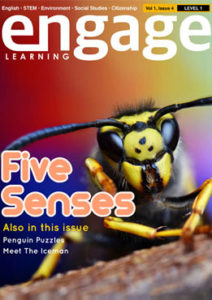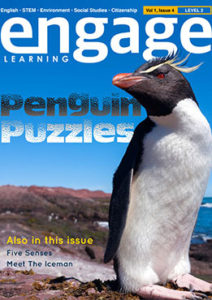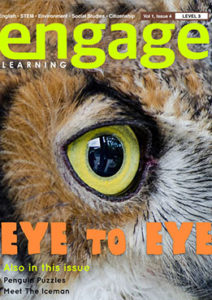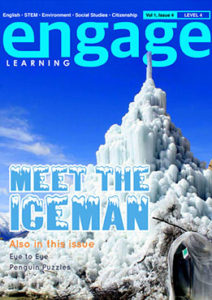“Engage Learning”: An interview with Pooja Vir
 Engage Learning is a new classroom science magazine, available in four reading levels for children between 3 and 13 years of age, launched in July 2017. Created especially with the children of India in mind, its content is thoroughly researched, with stories and activity pages complementing the school curriculum. The nonfiction content teaches STEM (Science, Technology, Engineering, Mathematics), environmental education and social studies, while improving vocabulary and introducing children to what scientists are doing in real science today. The richly-designed 32-page magazine with activities is published six times a year in July, August, September, November, January and February to coincide with the academic calendar.
Engage Learning is a new classroom science magazine, available in four reading levels for children between 3 and 13 years of age, launched in July 2017. Created especially with the children of India in mind, its content is thoroughly researched, with stories and activity pages complementing the school curriculum. The nonfiction content teaches STEM (Science, Technology, Engineering, Mathematics), environmental education and social studies, while improving vocabulary and introducing children to what scientists are doing in real science today. The richly-designed 32-page magazine with activities is published six times a year in July, August, September, November, January and February to coincide with the academic calendar.
Here are links to the Flip Books from the August 2017 issue.
Schools and educational institutions receive preferential rates. When a school subscribes they also receive Teaching Guides with worksheets, answer keys, additional activities and links to videos that will help them explore the subject even further with their students.
Engage Learning is created by an international team of experienced classroom magazine writers and local curriculum advisors.
 Lata Vasvani – began her career with India Book House. She went on to become their head of sales and subscriptions as well as co-found Crossword, the bookstore. She then went on to lead the launch and sales of National Geographic Explorer in India. Lata leads all school relationships and sales for Engage Learning.
Lata Vasvani – began her career with India Book House. She went on to become their head of sales and subscriptions as well as co-found Crossword, the bookstore. She then went on to lead the launch and sales of National Geographic Explorer in India. Lata leads all school relationships and sales for Engage Learning.
Francis Downey – has been involved with education for more than 35 years as a lecturer, teacher, and publisher. His career has included work with the Dinosaur State Park in Connecticut (designing curriculum that integrated environmental instruction with core curriculum); various planetariums and science museums; teaching history for a decade at the college level (developed courses in US history, African-American history, the history of Puerto Rico, European history, and world history); National Geographic Explorer Magazine (leading the team that developed the magazine). Francis is Editorial Director at Engage Learning, responsible for all content.
Pooja Vir – Grew up in a family of publishers – with one grandfather having founded India Book House, and another the Hindi Milap newspaper. She is responsible for Engage Learning’s communications and digital divisions. 
Excerpts of an email interview with Pooja Vir:
Why did you start these school magazines? We created Engage Learning to engage students in nonfiction reading and learning. If you ask a teacher what her/his greatest challenge is today, you will find that it is engaging students in the learning process. Once the student is engaged, the teacher can teach just about anything. We do this through great storytelling and fantastic photos. We also differ from textbooks in that we provide depth and context. A textbook provides a lot of facts and breadth, but cannot develop context. We also work with scientists on our stories and report on what they are doing in real science today. Far too often textbooks concentrate on the science of the past and rarely update their content to what is also being done today.
What prompted you to launch a digital and a print version when most firms are opting for digital? We want teachers and students to be able to access the content on their preferred platform. They may prefer one over the other. Or, if they are like many people, they may want to use print at certain times and digital at others. We are also integrating digital material into the print product through QR Codes that allow students to use their devices to continue the learning. We are really platform agnostic. We want students to access the content any way they want to and when they want to.
How do you propose to enter the school market? Will parents and educators subscribe to the magazine? Is it not an additional expense to the school fees etc? We look at it as an essential expense for schools/parents, and not an extra expense. By engaging students in the learning process, teachers will save time. Also by giving students an authentic reading experience through a magazine that looks like it could be purchased on the newsstand, students will want to read this teaching tool. The magazine format provides a less intimidating format than a textbook. How many children or adults want to read a textbook? As far as how we propose to enter the school market – given our directors existing relationships with several hundred school principals we introduced the magazine via prototypes in January this year and have since been following up individually with each school which have resulted in our current school subscriptions. We also conducted teacher’s training and demo workshops in our subscriber schools in Dharamshala, Mumbai and Chennai.
What are the extra features that the digital version will offer as compared to the print edition? I did not see anything else except for it being a flip book version of the print edition? Right now they are identical, but as we move ahead, we will be adding extra features to both (including voice and video). We are somewhat limited by accessibility. The digital infrastructure in many schools is insufficient and cannot handle a sophisticated digital experience. We provide teachers with the material that they can use in the classroom right now and will add to it as the infrastructure improves. Also, many schools push back on too much digital content. For instance, despite the tremendous teaching power that mobile devices offer, most schools do not allow them. As this environment changes, we will adapt to it. We are already pushing schools to do more digitally.
Who is selecting the content for these magazines? We look at school curriculum and then select stories that support and augment that curriculum. Story suggestions come from a variety of sources, including teachers and students. We also work with a variety of scientists from around the world. They tell their stories and relate them to school curriculum. We are also working with a school curriculum advisor who helps inform the story choices.
All though the magazines are levelled readers the content seems to be more or less the same except scaled to the age appropriate reader. Is that the case? The same basic story is told in all four editions, but the content is levelled. For example, we covered a boiling river in our second issue. This river which flows in Peru is nearly boiling hot. In Levels 3-4, the stories were basically the same. In Level 2, we used the boiling river to talk about how water changes shape and state, and then ended with the water cycle. In Level 1, we used the boiling river as an entry into what a river is. So we changed the content to match what is appropriate at each level. Sometimes that changes are subtle. At other times they are transparent.
3 January 2018

